Key Points
Global macroeconomic drivers: Important economic data in April (employment, inflation, GDP) and central bank decisions from various countries will significantly impact cryptocurrencies, as digital assets have become highly correlated with overall risk sentiment.
Central bank policy trends: Many central banks are shifting towards easing policies or maintaining interest rates, which typically promotes risk appetite, benefiting Bitcoin and major altcoins.
U.S. "Tariff Liberation Day": On April 2, the U.S. will announce new tariff measures. Harsh tariffs may trigger risk-averse sentiment, while more moderate policies are expected to boost market sentiment.
Key market volatility windows: Cryptocurrency traders should pay attention to April 4, 10, 16, 17, and 30, as economic data and policy signals on these days may lead to market turbulence, and they should prepare risk hedging and management strategies in advance.

In April 2025, global economic events are dense, including the U.S. employment report, China's Q1 GDP, major central bank decisions, and U.S. tariff policies that could change the global market landscape, all of which will influence market sentiment. For cryptocurrency traders, the importance of macro events has surpassed previous levels, with Bitcoin and other digital assets increasingly linked to global financial markets. Understanding how interest rate changes, inflation data, and geopolitical trends affect risk appetite is key for traders to successfully navigate cryptocurrency price fluctuations.
Table of Contents
Macroeconomic Background Analysis
Why Are Macroeconomic Factors Still Crucial for Cryptocurrencies?
U.S. Section: Dominating Global Market Sentiment
April 2 – U.S. "Tariff Liberation Day"
April 4 – U.S. Employment Report
April 9 – Federal Reserve (FOMC) Meeting Minutes
April 10 – U.S. Consumer Price Index (CPI)
April 30 – U.S. Q1 GDP and Core Personal Consumption Expenditures (Core PCE)
Europe and the UK: Monetary Easing, Inflation, and Economic Growth
Early April – Eurozone Flash CPI
April 17 – European Central Bank (ECB) Interest Rate Decision
April 15–16 – UK Economic Data
Late April – Eurozone Q1 GDP
China Section: Q1 GDP and Global Impact
April 16 – China Q1 GDP
Trade and inflation data
Japan Section: Maintaining Caution in April, Acting in May
No Bank of Japan (BoJ) meeting in April
Late April – Japan Consumer Price Index (CPI)
Other Central Banks and Important Events
April 1 – Reserve Bank of Australia (RBA)
April 9 – Reserve Bank of New Zealand (RBNZ)
April 16 – Bank of Canada (BoC)
April 3 – OPEC+ Meeting
April 21–23 – International Monetary Fund (IMF) and World Bank Meeting
Cryptocurrency Market Dynamics: Key Considerations
Cryptocurrency Trader Strategy Recommendations
Macroeconomic Background Analysis
In 2025, the pace of global economic expansion has significantly slowed, following a strong recovery from the pandemic in the previous two years. The inflation pressures that surged between 2023 and 2024 have eased considerably under tightening monetary policies and stable energy prices. Meanwhile, geopolitical uncertainties such as trade disputes and regional conflicts continue to cause market volatility.
In Europe, the lingering effects of the long-term conflict in Ukraine still impact energy markets and government fiscal decisions, although tensions have eased compared to previous years. At the same time, many central banks are inclined to cut rates or pause rate hikes to sustain economic growth and prevent inflation from resurging.
The once relatively independent cryptocurrency market is now particularly sensitive to changes in macro policies. When central banks shift to easing, risk appetite increases, driving funds into Bitcoin, Ethereum, and other digital assets; conversely, if inflation rises again or significant geopolitical risks emerge, traders often retreat from speculative assets to safer investment tools.
Why Are Macroeconomic Factors Still Crucial for Cryptocurrencies?
While some view Bitcoin as a safe-haven asset, by 2025, Bitcoin often fluctuates in sync with the stock market and other risk assets. Institutional investors frequently adjust their asset allocations based on global liquidity and market sentiment. When central banks adopt a dovish stance, risk assets, including cryptocurrencies, typically benefit; conversely, unexpected hawkish policies or pessimistic economic data can lead to a simultaneous decline in digital assets and traditional markets.
The global economy has experienced explosive growth post-pandemic, but the growth momentum has clearly cooled. Although the peak of inflation in 2023–2024 has passed, the new U.S. tariff policies and potential energy risks remain a significant concern. Below are key events in April, their potential impacts on the overall market, and the time points that cryptocurrency traders need to focus on:
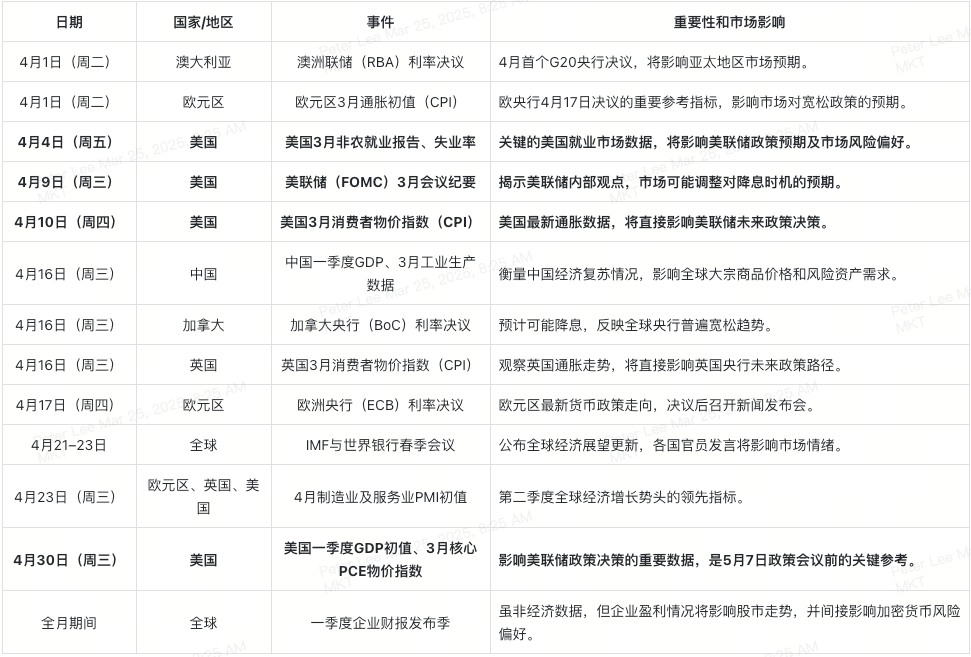
U.S. Section: Dominating Global Market Sentiment
April 2 – U.S. "Tariff Liberation Day"
Former U.S. President Trump plans to announce new "reciprocal" tariff measures on April 2. The market is concerned that this round of tariffs may be substantial, exacerbating trade frictions, inflation risks, and dragging down economic growth, negatively impacting both the stock market and cryptocurrencies. However, if the policy is relatively moderate, the market may see a relief rebound. The cryptocurrency market trades around the clock and will quickly reflect such significant news.

Image Credit: Bloomberg
April 4 – U.S. Employment Report
The U.S. non-farm employment report typically influences market expectations for the Federal Reserve's interest rate path. If employment data is poor, it may trigger recession concerns, but it could also increase market expectations for further easing by the Federal Reserve, leading to complex impacts on crypto assets. Conversely, unexpectedly strong employment data may lower market expectations for rate cuts, putting pressure on Bitcoin and altcoins in the short term.
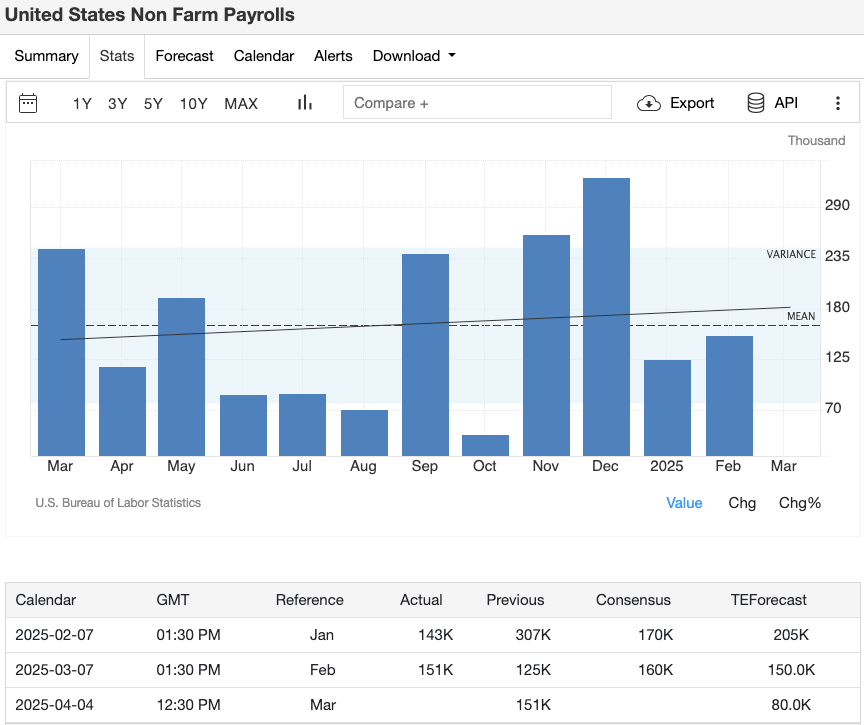
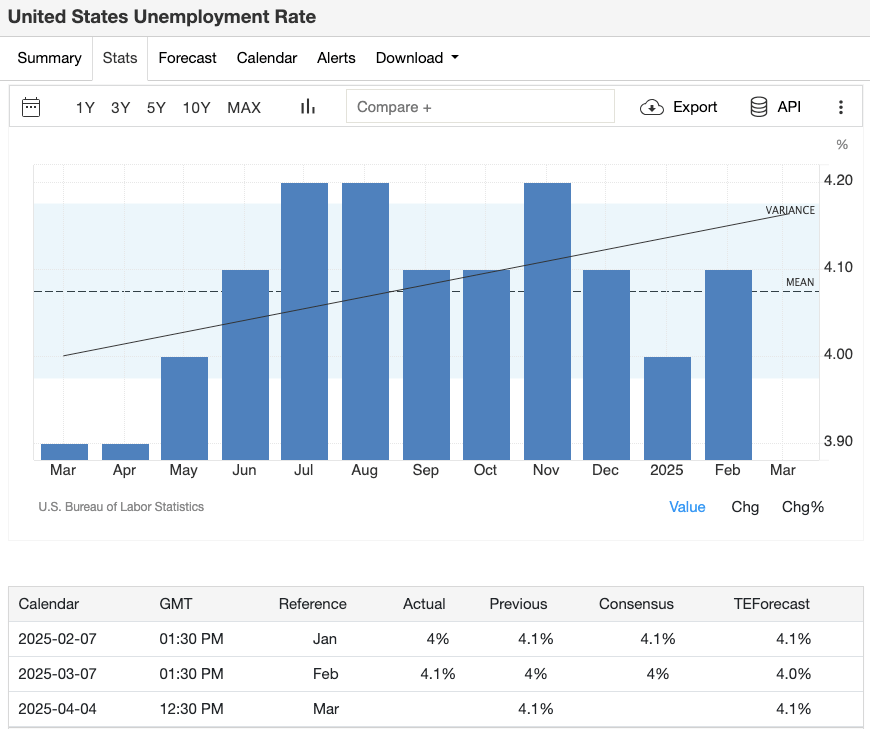
Image Credit: Economic Calendar
April 9 – Federal Reserve (FOMC) Meeting Minutes
There is no FOMC meeting in April, so traders will closely monitor the minutes from the March meeting to understand officials' views on inflation and economic risks. If officials lean towards further tightening, the market may readjust its expectations for rate cuts. Cryptocurrencies typically perform better under expectations of monetary policy easing.
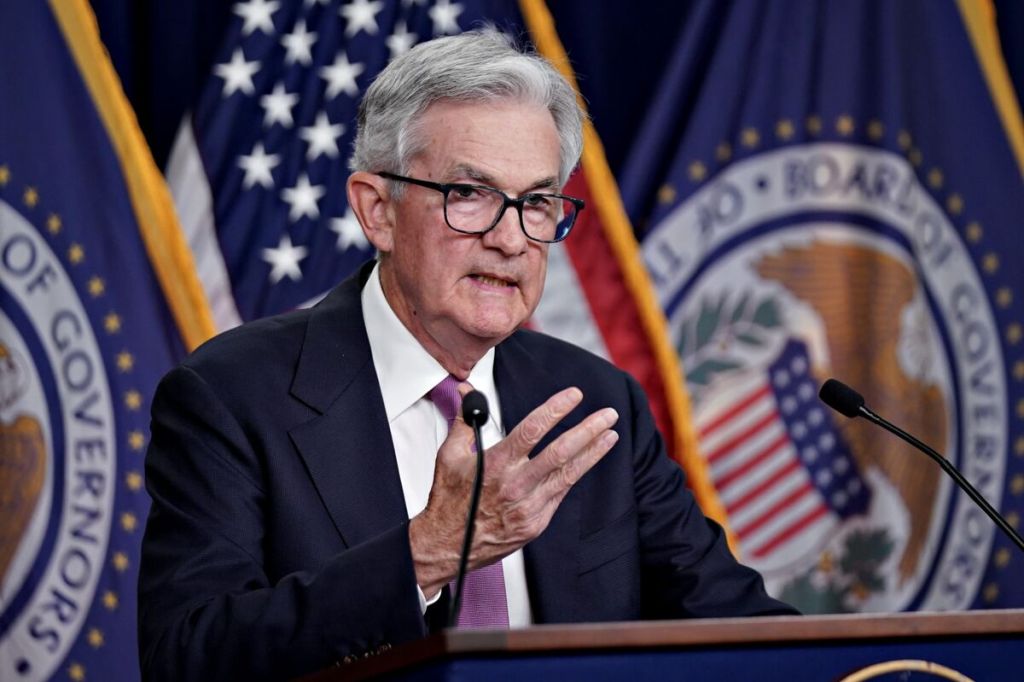
Image Credit: Inside the Hood
April 10 – U.S. Consumer Price Index (CPI)
U.S. inflation data remains a key indicator. The year-on-year increase in February moderated to 2.8%, providing room for the Federal Reserve to pause interest rate hikes. However, if March inflation data shows a rebound, it could weaken market expectations for recent rate cuts. The cryptocurrency market typically benefits from ample liquidity, and if the market becomes concerned about tightening policies, the price volatility of crypto assets will increase.
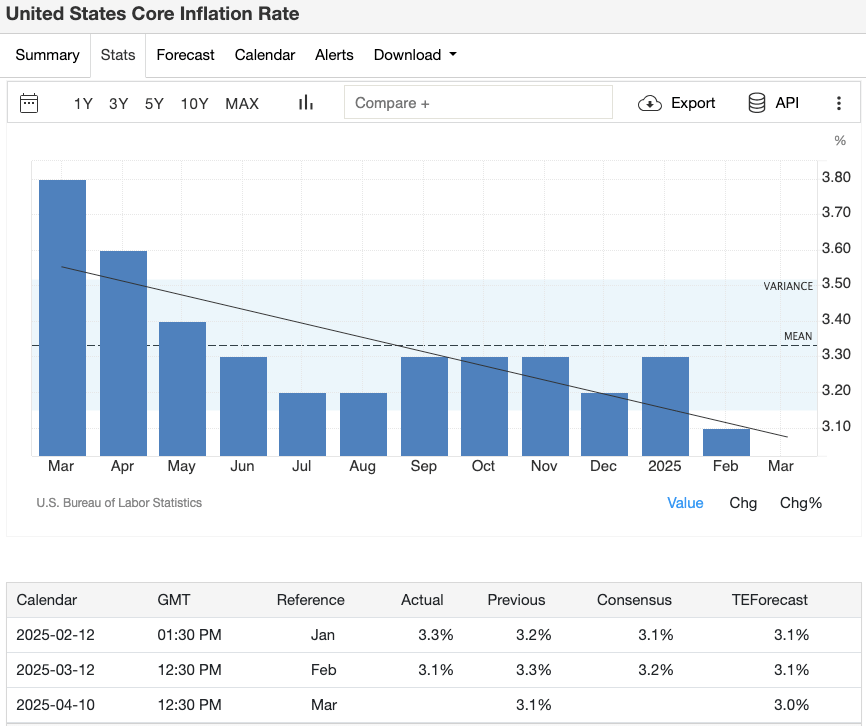
Image Credit: Economic Calendar
April 30 – U.S. Q1 GDP and Core PCE
At the end of April, the preliminary U.S. Q1 GDP and the core Personal Consumption Expenditures (PCE) price index, closely monitored by the Federal Reserve, will be released. If the GDP data is weak, the market may once again worry about recession risks, while the Fed's dovish stance may be further reinforced. Additionally, if the core PCE shows weak inflation pressures, the market may bet on rate cuts ahead of time. These data will have a decisive impact on the Federal Reserve's policy decisions in early May and will drive the cryptocurrency market's movements.
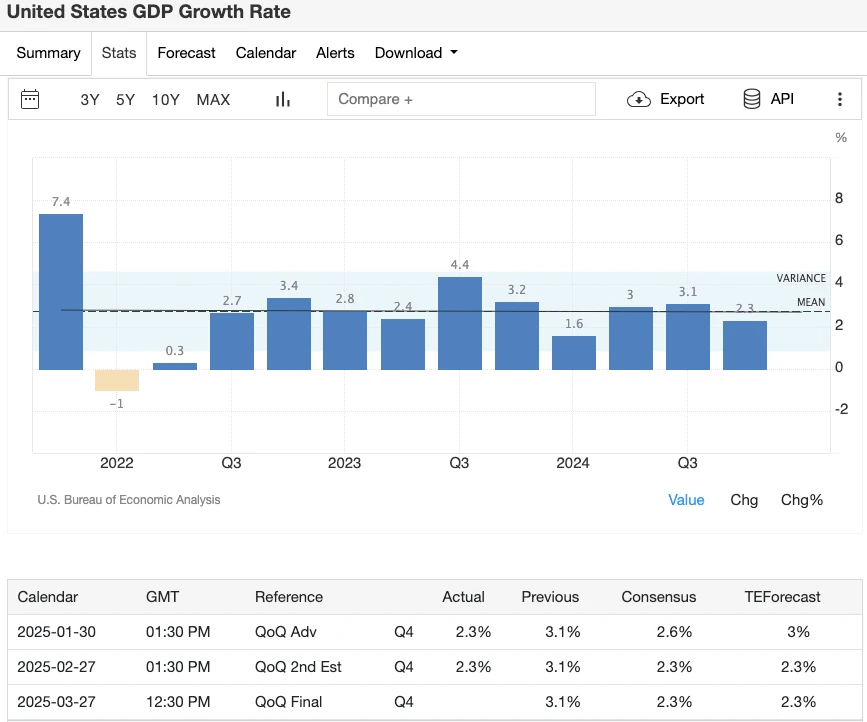
Image Credit: Economic Calendar
Europe and the UK Section: Monetary Easing, Inflation, and Economic Growth
Early April – Eurozone Flash CPI
Eurozone inflation has recently dropped to around 2–3%, significantly lower than in previous years. If this data continues to be weak, it will strengthen market expectations for the European Central Bank (ECB) to maintain an accommodative monetary policy, benefiting risk assets including cryptocurrencies. However, if inflation data unexpectedly rises, the ECB may adopt a more cautious stance.
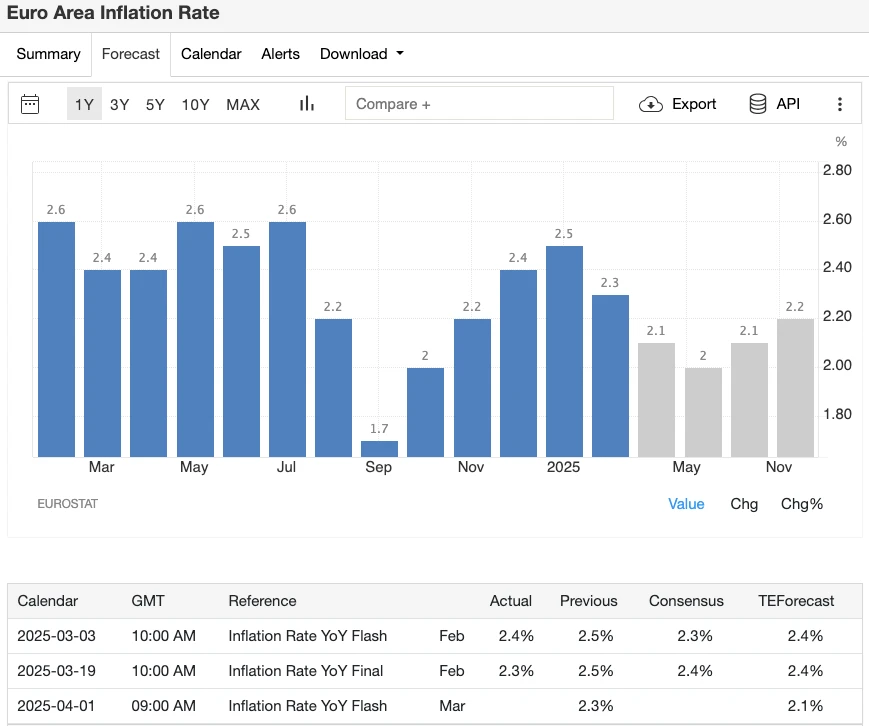
Image Credit: Economic Calendar
April 17 – European Central Bank (ECB) Interest Rate Decision
The ECB lowered the deposit rate to 2.65% in March. The market expects this decision to either remain unchanged or see a slight further cut. A dovish stance helps market liquidity, typically benefiting the crypto market; however, if the central bank unexpectedly turns hawkish (tightening policy), it may trigger risk-averse sentiment in the market, negatively impacting crypto assets.
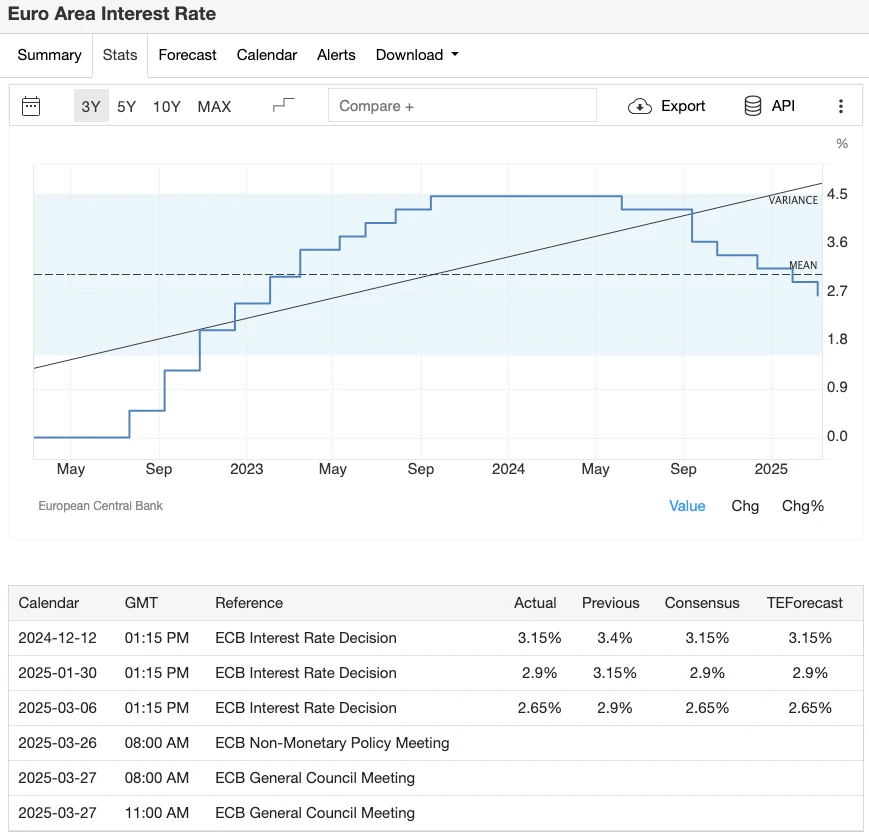
Image Credit: Economic Calendar
April 15–16 – UK Inflation and Employment Data
The UK will release March Consumer Price Index (CPI) and employment market data on April 15–16. This data will further clarify the Bank of England's (BoE) next policy path. Currently, the UK's inflation rate remains around 3%, along with robust wage growth, limiting the central bank's room for further rate cuts. However, if the data is unexpectedly weak, it may increase the likelihood of the central bank adopting more accommodative measures, indirectly stimulating demand for cryptocurrencies in the UK market.
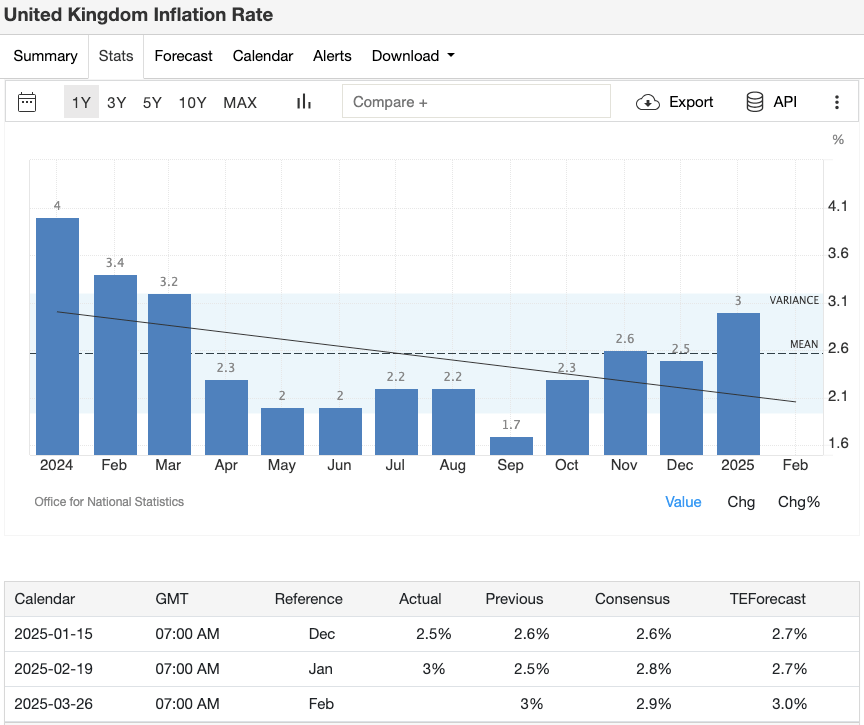
Image Credit: Economic Calendar
Late April – Eurozone Q1 GDP Data
The Eurozone's Q1 GDP data, expected to be released at the end of April, will indicate whether economic growth remains around 0.9%. If GDP performance is weaker than expected, it will exacerbate market concerns about economic recession; conversely, stronger data may reduce market expectations for further easing actions by the ECB. Both scenarios will significantly impact risk sentiment and affect the movements of the cryptocurrency market.

Image Credit: Economic Calendar
China Section: Q1 GDP Data and Global Market Linkage Effects
April 16 – China Q1 GDP
China's Q1 GDP data is an important barometer for global demand. The government's growth target is around 4%, but analysts generally predict that the actual growth rate may be close to 5%. If the GDP data is strong, it will boost demand for global commodities and risk assets, including cryptocurrencies; if the data is significantly below expectations, especially amid rising U.S.-China trade tensions, it may dampen market sentiment.
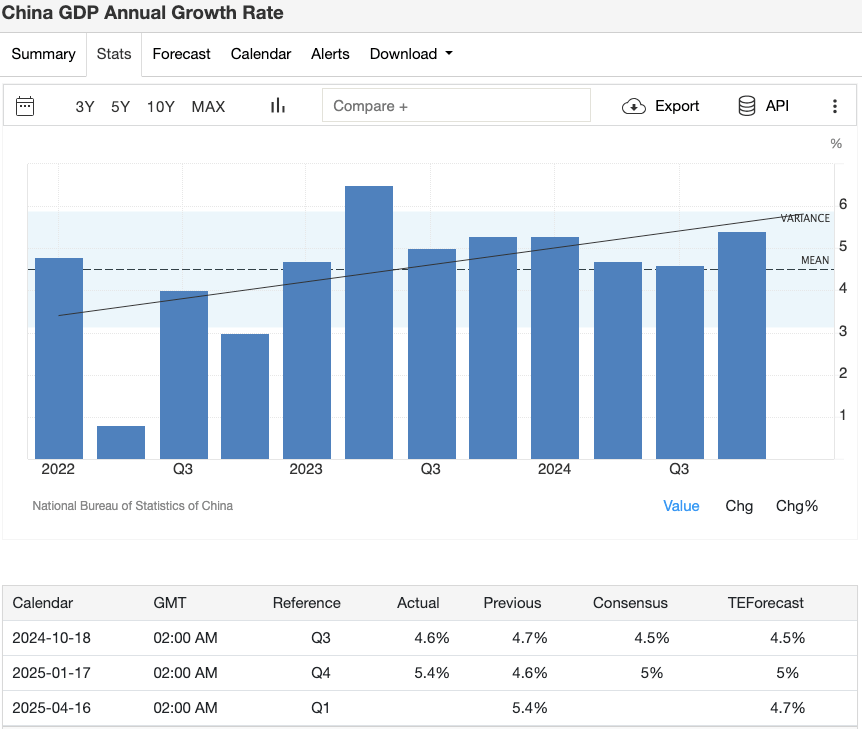
Image Credit: Economic Calendar
Mid-April – Trade and Inflation Data
In mid-April, China will release trade balance, industrial production, and inflation data. If export data performs strongly, it indicates robust external demand; a low inflation environment will also provide room for further policy easing. Cryptocurrency traders closely monitor Chinese economic data, as any additional stimulus policies or supply chain adjustments may impact expectations for global economic growth.

Image Credit: CNN
Japan Section: Policy on Hold in April, Focus on May Central Bank Direction
No Bank of Japan (BoJ) Meeting in April
The Bank of Japan's next monetary policy decision is scheduled for May 1. However, speeches from central bank officials or released data this month may still influence market expectations for the Yield Curve Control (YCC) policy. Currently, Japan's inflation remains around 3%, and the market is focused on when the central bank will exit its ultra-loose monetary policy. Any signs of a policy shift could impact global bond markets and the yen exchange rate, indirectly affecting the cryptocurrency market.

Image Credit: CNBC
Late April – Japan Consumer Price Index (CPI)
If Japan's March CPI continues to remain above the target, market speculation about the central bank potentially tightening policy will increase; conversely, if inflation data falls back, it may further confirm that the central bank will maintain an accommodative stance. Both scenarios will affect the foreign exchange market, influence overall market risk appetite, and transmit to the movements of the cryptocurrency market.
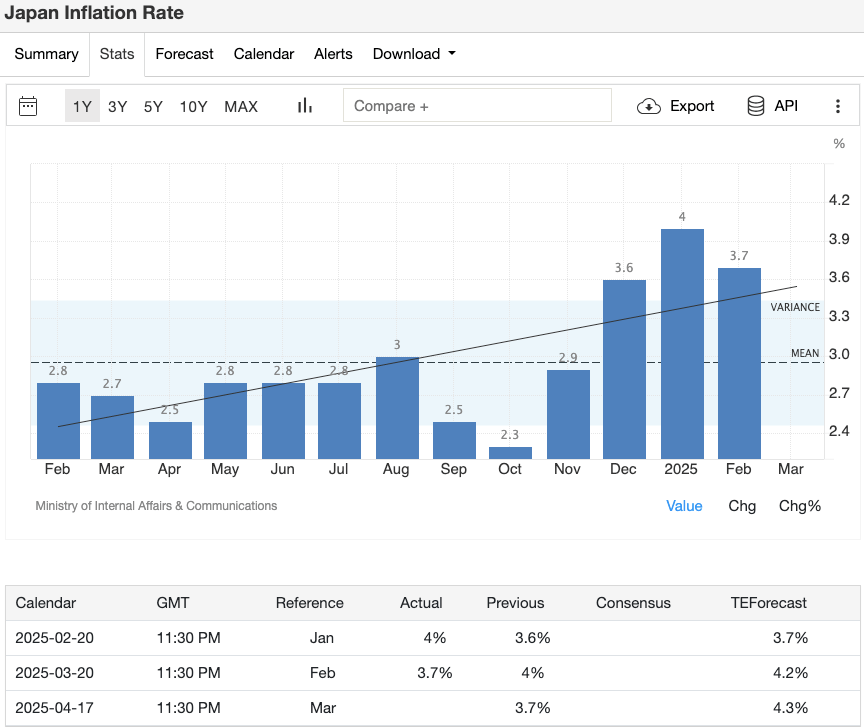
Image Credit: Economic Calendar
Other Central Banks and Important International Events
Australia (RBA, April 1) and New Zealand (RBNZ, April 9)
As domestic inflation gradually cools, both the Reserve Bank of Australia and the Reserve Bank of New Zealand have paused interest rate hikes. If the central banks signal the possibility of future rate cuts, it will strengthen market expectations for a trend of global central bank easing policies, typically benefiting the performance of risk assets, including cryptocurrencies.
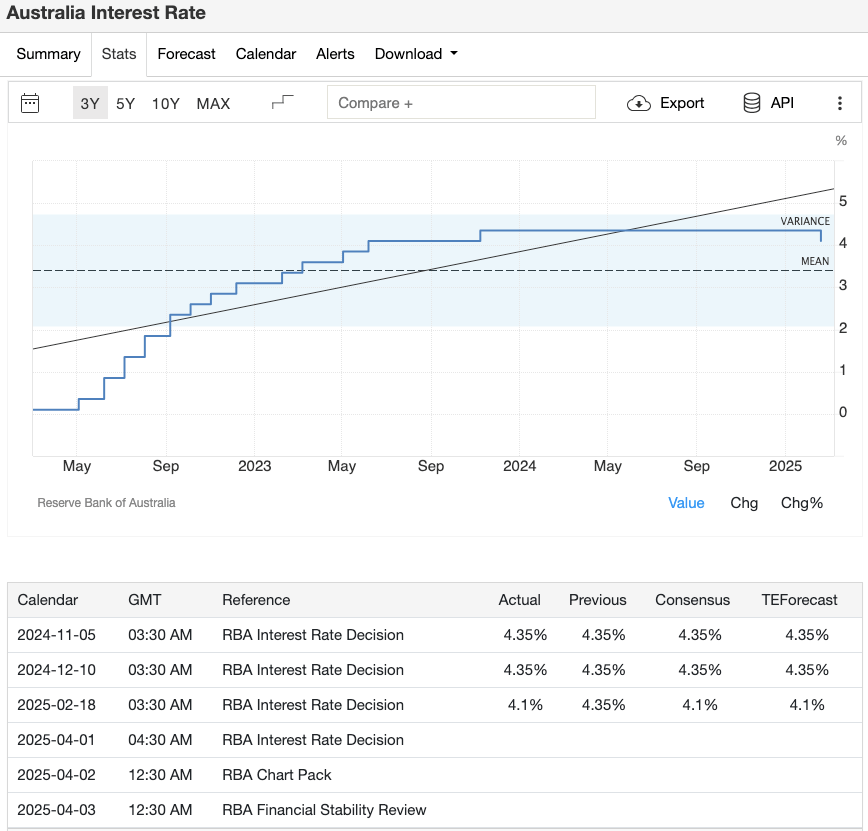
Image Credit: Economic Calendar
Bank of Canada (BoC) – April 16
The Bank of Canada has lowered its interest rate to 2.75%, and it is expected to further cut it to 2.50% in April. This dovish policy reflects the overall trend of global central banks moving towards easing, which is favorable for the performance of the crypto market.
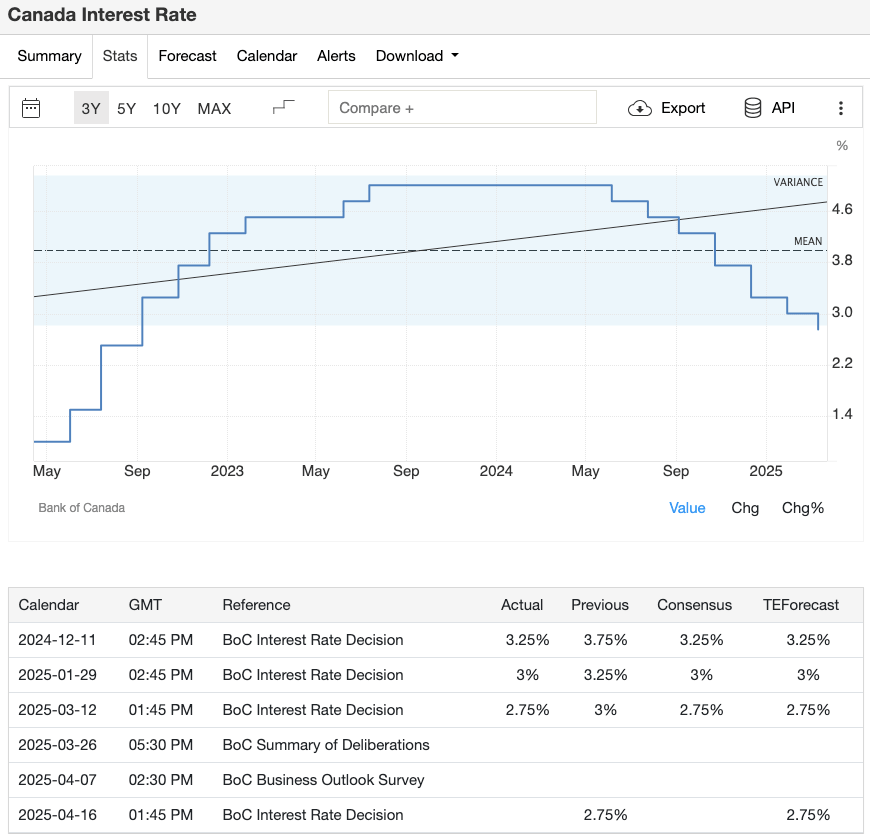
Image Credit: Economic Calendar
OPEC+ Meeting – April 3
The Organization of the Petroleum Exporting Countries (OPEC+) will hold a meeting on April 3 to discuss production policies. If a decision is made to cut production, oil prices may rise, increasing inflation pressures; if production levels are maintained or increased, it will help control inflation levels, creating conditions for central banks to maintain accommodative monetary policies, which is beneficial for the cryptocurrency market.

Image Credit: Leadership.ng
IMF and World Bank Spring Meetings – April 21 to 23
Finance ministers and central bank officials from around the world will gather in Washington to discuss the global economic growth outlook. The IMF may adjust its economic growth forecasts. If the forecasts are pessimistic or warnings are issued regarding trade and debt risks, it will negatively impact the market; conversely, if positive signals of stable economic growth are released, it will benefit market risk sentiment.

Image Credit: Pakistan & Gulf Economist
Cryptocurrency Market Dynamics: Key Considerations
Inflation and Interest Rates
When inflation levels remain moderate, central banks have room to cut interest rates or keep them unchanged, which is generally favorable for cryptocurrencies. However, if inflation unexpectedly rises, central banks may lean towards tightening policies, which would be detrimental to Bitcoin and other cryptocurrencies.
Market Risk Appetite (Risk-On vs. Risk-Off)
Cryptocurrencies typically rise alongside the stock market during periods of market risk appetite (Risk-On). If trade conflicts escalate, geopolitical risks increase, or economic data is poor, the market may shift to risk aversion (Risk-Off), potentially exposing the cryptocurrency market to downside risks.
Correlation with the Stock Market
Many institutional investors view Bitcoin as an asset class similar to tech stocks, and significant volatility in the stock market often reflects in the crypto market as well.
Tariff Policy Focus
If the U.S. tariff policy on April 2 is unexpectedly harsh, it may overshadow the impact of other economic data on the market; conversely, if the policy is moderate, it may trigger a calming sentiment in the market, benefiting various risk assets, including cryptocurrencies.
Cryptocurrency Trader Strategy Recommendations
Maintain Market Sensitivity
Traders should closely monitor important economic event dates in April, including the U.S. employment report (April 4), U.S. CPI (April 10), China GDP (April 16), European Central Bank meeting (April 17), and U.S. GDP and PCE inflation data (April 30). The crypto market reacts quickly, especially during non-traditional trading hours, where significant volatility is more likely.
Manage Market Volatility Risks
Utilize tools such as options and futures for risk hedging before and after major events. Set reasonable stop-loss orders to avoid significant losses triggered by unexpected data or policy news.
Pay Attention to Dollar and Bond Yield Trends
When the dollar strengthens or bond yields rise, funds may withdraw from risk assets like Bitcoin; conversely, when yields fall, market risk appetite typically increases, generally benefiting cryptocurrency prices.
Respond Quickly to Market Changes
The crypto market trades 24/7, so traders need to remain vigilant, especially when significant news or events occur during stock market closures, and be ready to take action.
Conclusion
April 2025 will be a crucial juncture for global financial markets, with major central bank policies, a flurry of economic data releases, and important U.S. tariff policies all having a profound impact on market sentiment. Cryptocurrency traders should closely monitor the developments of these events, as digital assets are highly sensitive to inflation trends, changes in monetary policy, and geopolitical tensions.
If inflation remains stable and U.S. tariff policies are relatively moderate, market risk appetite may strengthen, driving Bitcoin and mainstream cryptocurrencies to continue rising; however, if inflation unexpectedly rebounds, tariff measures intensify, or economic data is weak, market risk appetite may be undermined. Traders can effectively grasp market trends in this critical month and even position themselves for mid-2025 market directions by continuously monitoring macroeconomic dynamics, implementing prudent risk management, and deeply understanding how these factors impact digital assets.
Additionally, paying attention to the correlation between cryptocurrencies and traditional markets (especially stocks and interest rates) can help traders quickly assess the market response of digital assets. Closely monitoring specific dates for employment, inflation, GDP data, and central bank policy communications will also effectively assist traders in seizing investment opportunities arising from market volatility.
Quick Links
March Global Economic Dynamics: A Must-Read for Crypto Investors
Nine Major Trends in Cryptocurrency for 2025: AI, DeFi, Tokenization, and More Innovations
Beyond Candlestick Charts: How On-Chain Data and Macro Trends Drive Bitcoin Growth
Monad vs. Ethereum: Can This Emerging L1 Disrupt the Market?
About XT.COM
Founded in 2018, XT.COM currently has over 7.8 million registered users, with over 1 million monthly active users and user traffic exceeding 40 million within the ecosystem. We are a comprehensive trading platform supporting over 800 quality cryptocurrencies and more than 1,000 trading pairs. XT.COM cryptocurrency trading platform supports a rich variety of trading options, including spot trading, margin trading, and futures trading. XT.COM also has a secure and reliable NFT trading platform. We are committed to providing users with the safest, most efficient, and most professional digital asset investment services.
免责声明:本文章仅代表作者个人观点,不代表本平台的立场和观点。本文章仅供信息分享,不构成对任何人的任何投资建议。用户与作者之间的任何争议,与本平台无关。如网页中刊载的文章或图片涉及侵权,请提供相关的权利证明和身份证明发送邮件到support@aicoin.com,本平台相关工作人员将会进行核查。




